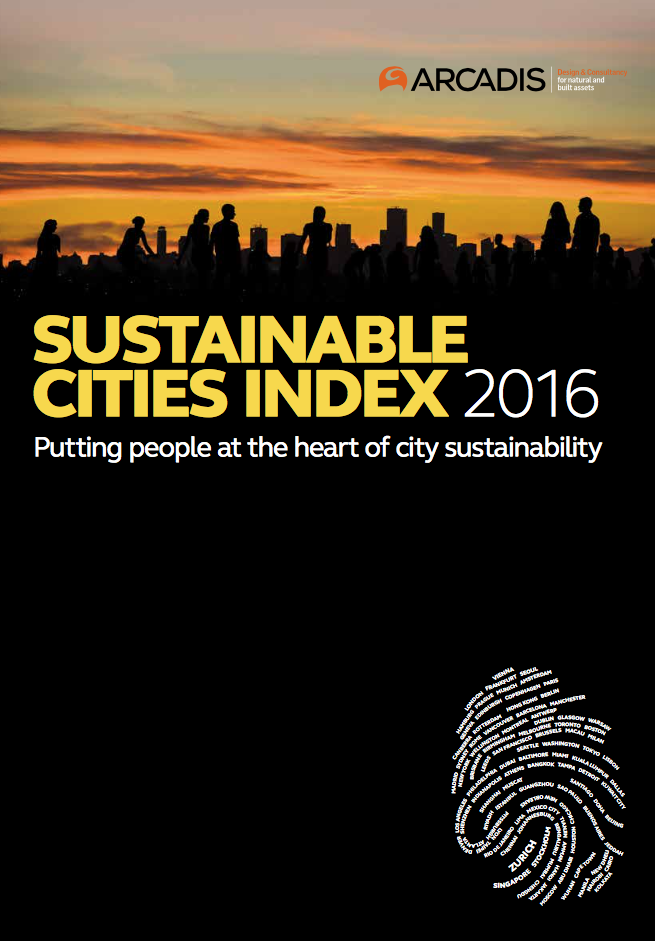
Zürich groenste stad, ‘Nederland blijft wat achter’
13 september 2016 – Het ingenieursbureau Arcadis heeft voor de tweede keer een Duurzame Steden Index uitgebracht. Van honderd wereldsteden staat Zürich bovenaan als groenste stad. Rotterdam en Amsterdam staan op plaats zeventien en negentien. Arcadis: ‘Nederland blijft wat achter’.
 De Index onderzocht honderd wereldsteden op sociale (people), omgevings- (planet) en economische (profit) factoren. Er staan zestien Europese steden – waaronder Amsterdam en Rotterdam – in de top 20. Arcadis: ‘Ondanks deze goede score kunnen Europese steden nog wel verbeteren als het gaat om de balans tussen de drie pilaren van duurzaamheid’.
De Index onderzocht honderd wereldsteden op sociale (people), omgevings- (planet) en economische (profit) factoren. Er staan zestien Europese steden – waaronder Amsterdam en Rotterdam – in de top 20. Arcadis: ‘Ondanks deze goede score kunnen Europese steden nog wel verbeteren als het gaat om de balans tussen de drie pilaren van duurzaamheid’.
Carolien Gehrels, Europees directeur grote steden van Arcadis is blij met de timing van de index: ‘In oktober 2016 vindt in Quito, Ecuador de UN Habitat III conferentie plaats, die eens in de twintig jaar wordt gehouden. Daar wordt de agenda gezet voor komende decennia op het gebied van duurzaamheid in steden. Ik hoop dat onze Sustainable Cities Index een bijdrage kan leveren in de discussie om steden meer duurzaam te maken.’’
Uit de Executive Summary
- ‘(…) The 2016 Arcadis Sustainable Cities Index ranks 100 global cities on three dimensions of sustainability: people, planet and profit. These represent social, environmental and economic sustainability and offer an indicative picture of the health and wealth of cities for the present and the future.
- The research shows that cities around the world are not effectively balancing these three pillars of sustainability. Instead, many demonstrate split personalities. While taking the lead in some areas, cities often underperform in one element of sustainability which negatively impacts their overall performance.
- Zurich leads the overall ranking and tops the planet sub-index. But, while it scores highly in profit, it reveals its split personality by appearing in 27th place for people.
- Well-established European cities dominate the top of the ranking, making up 13 of the 15 leading places. Global hubs such as London (5th), Frankfurt (6th) and Paris (15th) perform well. In the two remaining places are the Asian cities of Singapore (2nd) and Seoul (7th).
- The Asian cities of Singapore and Hong Kong rank highly in profit performance, but this seems to be straining social sustainability. Factors such as the high cost of living mean these cities, sitting first and second in the profit rankings, place 48th and 81st respectively for people.
- In North America, the Canadian city of Vancouver (23rd) takes the region’s top spot, but no U.S. city makes it into the top quartile. New York is the country’s most sustainable city (26th globally) and does particularly well in the profit sub-index (8th place), but at 77th has room to improve on its people ranking. Vancouver and New York are followed by Montreal (28th) and Toronto (33rd) in the region.
- San Francisco, New York and Dallas follow the global trend of having higher rankings for profit but lower rankings for people.
- UAE cities lead the Middle East rankings, with Dubai as the best- performing city in 52nd spot, closely followed by Abu Dhabi in 58th.
- Cities in Australasia sit well within the top half of the ranking. Canberra (18th) leads the way in that region, followed by Sydney (21st).
- Fast-growing, emerging cities in Asia, Latin America, Africa and the Middle East make up much of the fourth quartile of the Index, with many facing significant challenges across each area of sustainability.
- The Brazilian cities of São Paulo and Rio de Janeiro sit out in front of their continental counterparts in the planet sub-index, ranking in 30th and 38th place.
- The span of median ages across the cities in the Index is vast, ranging from just 18.7 years in Nairobi to 46.6 years in Tokyo.
- In order to improve their sustainability, city leaders are encouraged to put people at the heart of their sustainability plans and use the Index to help them to compare and learn from similar cities across the world.
- This journey begins with a clear assessment of where a city is today, identifying the outputs, positive and negative, arising from the interplay between the city’s physical, social and economic systems. This will help cities achieve a better balance across each of the pillars of sustainability. (…)’
Bronnen
Arcadis, 12 september 2016: Sustainable Cities Index 2016
Arcadis, rapport, 12 september 2016: Sustainable Cities Index 2016 (pdf)
Foto: FluxEnergie/© Paul Tolenaar



